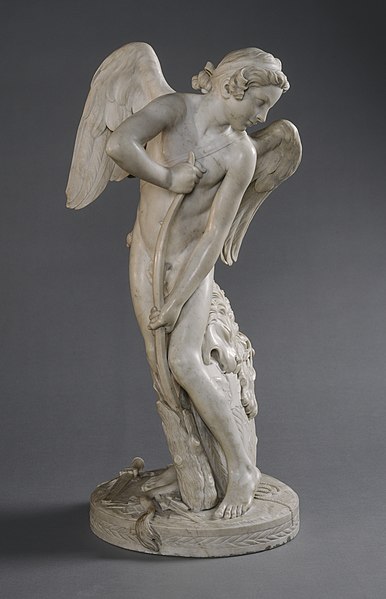In classical mythology, Cupid is the god of desire, erotic love, attraction and affection. He is often portrayed as the son of the love goddess Venus and the god of war Mars. He is also known as Amor. His Greek counterpart is Eros.
Although Eros is generally portrayed as a slender winged youth in Classical Greek art, during the Hellenistic period, he was increasingly portrayed as a chubby boy. During this time, his iconography acquired the bow and arrow that represent his source of power: a person, or even a deity, who is shot by Cupid's arrow is filled with uncontrollable desire. In myths, Cupid is a minor character who serves mostly to set the plot in motion. He is a main character only in the tale of Cupid and Psyche, when wounded by his own weapons, he experiences the ordeal of love. Although other extended stories are not told about him, his tradition is rich in poetic themes and visual scenarios, such as "Love conquers all" and the retaliatory punishment or torture of Cupid.

Classical statue of Cupid with his bow
Cupid Carving His Bow (1620s) by François Duquesnoy, Bode Museum, Berlin
A blindfolded, armed Cupid (1452/66) by Piero della Francesca
Edme Bouchardon, Cupid, 1744, National Gallery of Art
Venus is a Roman goddess, whose functions encompass love, beauty, desire, sex, fertility, prosperity, and victory. In Roman mythology, she was the ancestor of the Roman people through her son, Aeneas, who survived the fall of Troy and fled to Italy. Julius Caesar claimed her as his ancestor. Venus was central to many religious festivals, and was revered in Roman religion under numerous cult titles.
Venus rising from the sea, alluding to the birth-myth of Greek Aphrodite. From a garden wall at the Casa della Venere in conchiglia, Pompeii. Before AD 79
A 2nd- or 3rd-century bronze figurine of Venus, in the collection of the Museum of Fine Arts of Lyon
Venus and Mars, with Cupid attending, in a wall painting from Pompeii
Imperial image of Venus suggesting influence from Syria or Palestine, or from the cult of Isis








